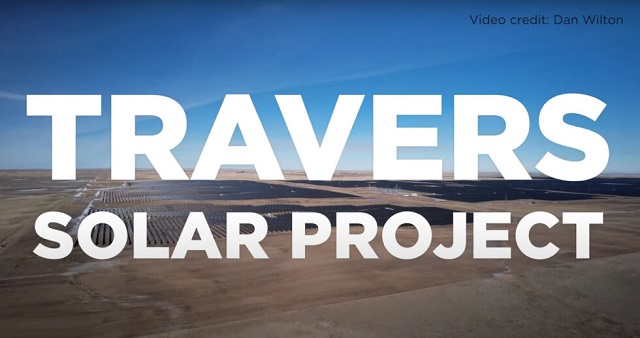Alberta
On Friday, Alberta’s energy minister hailed their largest solar project. On Sunday, it was producing 10.9% at noon

This was the opening splash for a video clip posted by the Alberta energy minister on social media. Two days later, its power output at noon was barely 11 per cent. YouTube/Canadian Energy Centre
From PipelineOnline.ca
Brian Zinchuk is editor and owner of Pipeline Online
And wind was doing even worse
Even though Alberta’s build-out of 38 wind farms and 36 solar farms have resulted in an enormous growth of nameplate power generating capacity, the reality was far from the advertised on Sunday, according to data from the Alberta Electric System Operator (AESO).
Despite the noon hour being defined as the sun being at its highest point in the sky, Alberta’s grid-scale solar facilities were having a tough day on Oct. 22. At 11:53 a.m., solar was producing 152 megawatts out of an installed base of 1,292 megawatts. That was 11.8 per cent of capacity. On a good day, that number is closer to 1,000 megawatts around noon.

Power generation in Alberta at 11:53 a.m. on Oct. 22. All numbers are in megawatts, MC is maximum capacity, and TNG is total net to grid. Alberta Electric System Operator
It wasn’t hard to figure out why solar hand tanked. A belt of heavy clouds, visible from Environment and Climate Change Canada satellite imagery, blanketed the principle solar power production region of southern Alberta.

Heavy clouds covered southern Alberta at 11:30 a.m. on Sunday. Environment and Climate Change Canada
Travers, the largest solar facility in Canada with a rated capacity of 465 megawatts and having cost $700 million, was producing 51 megawatts a few minutes before noon. That was 10.9 per cent. Ironically, Alberta Energy Minister Brian Jean had posted on LinkedIn on Oct. 20, “Did you know Alberta is home to Canada’s largest solar farm? Once we set clear rules around land use, reclamation and transmission, we’ll get back to work leading Canada and the world on renewable electricity. I’m proud of our energy workers. Check out this incredible clip 👇”
That 22 second video clip was originally posted by the Canadian Energy Centre, the Alberta government’s “war room,” whose mission is to set the record straight, as it were. “The Canadian Energy Centre’s mandate is to promote Canada as the supplier of choice for the world’s growing demand for responsibly produced energy,” says the Centre’s mandate.
Wind peters out
And wind power production was having an even worse day, with wind power plummeting as the morning turned into afternoon. By that time, wind was generating just 67 megawatts out of an installed based of 3,853 megawatts. That’s just 1.7 per cent of nameplate capacity.
So at that moment, combined wind and solar were producing 219 megawatts out of a nameplate capacity of 5,145, or 4.3 per cent of capacity.
Alberta’s final remaining coal-fired power facility was producing 802 of 820 megawatts of nameplate capacity, or 97.8 per cent. And its power output was 3.7 times the total output of all grid-scale wind and solar across Alberta, from 36 solar farms and 38 wind facilities, composed of hundreds of turbines and costing billions of dollars. As noted above, Travers, alone, cost $700 million and covers 3,330 acres with 1.3 million solar panels.
That last remaining coal plant, the Genesee Power Station, will soon be converted to natural gas, meaning an end to coal-fired power generation in Alberta – a province whose coal reserves run from Edmonton southwest to the BC and US borders.
The wind situation stayed much the same throughout the afternoon, and by 4:18, solar had dropped to 69 megawatts and wind was just 83 megawatts.

Wind generation in Alberta at 11:53 a.m. on Oct. 22. Twenty-four of 38 wind farms were producing exactly zero power at that moment. All numbers are in megawatts, MC is maximum capacity, and TNG is total net to grid. Alberta Electric System Operator
And near the supper hour, X bot account @ReliableAB noted AESO data showing wind was producing 86 megawatts and solar was producing 28 megawatts. At that moment, fossil fuels, principally natural gas, accounted 94.3 per cent of Alberta’s electricity. Alberta was getting 345 megawatts of power from imports, and batteries were contributing zero megawatts.
At this moment 94.3% of Alberta's electricity is being produced by fossil fuels. Wind is at 2.2% of capacity and producing 0.9% of total generation, while solar is at 2.2% of capacity and producing 0.29% of total generation. At the same time we are importing 345 MW or 3% pic.twitter.com/3gCrbqKvaI
— Reliable AB Energy (@ReliableAB) October 22, 2023
That 94.3 per cent is significant, because the federal government’s clean electricity regulations will require “unabated” fossil fuel power generation to shut down by 2035, with the exception that unabated natural gas generation could be used for up to 450 hours per year, per generator. As Premier Danielle Smith has pointed out, those hours would have been used up by the end of January in the calendar year of 2023, meaning by this time of year, Alberta’s grid, if those regulations were followed to the letter, would effectively be in almost total blackout. And to compound the situation, not only does the federal government expect provinces like Alberta and Saskatchewan to replace all that power generation in 11 years, two months and nine days, but also be on the path of increasing total power generation by a factor of 2.5x in 26 years, two months and nine days.
Brian Zinchuk is editor and owner of Pipeline Online
Alberta
Made in Alberta! Province makes it easier to support local products with Buy Local program

Show your Alberta side. Buy Local. |
When the going gets tough, Albertans stick together. That’s why Alberta’s government is launching a new campaign to benefit hard-working Albertans.
Global uncertainty is threatening the livelihoods of hard-working Alberta farmers, ranchers, processors and their families. The ‘Buy Local’ campaign, recently launched by Alberta’s government, encourages consumers to eat, drink and buy local to show our unified support for the province’s agriculture and food industry.
The government’s ‘Buy Local’ campaign encourages consumers to buy products from Alberta’s hard-working farmers, ranchers and food processors that produce safe, nutritious food for Albertans, Canadians and the world.
“It’s time to let these hard-working Albertans know we have their back. Now, more than ever, we need to shop local and buy made-in-Alberta products. The next time you are grocery shopping or go out for dinner or a drink with your friends or family, support local to demonstrate your Alberta pride. We are pleased tariffs don’t impact the ag industry right now and will keep advocating for our ag industry.”
Alberta’s government supports consumer choice. We are providing tools to help folks easily identify Alberta- and Canadian-made foods and products. Choosing local products keeps Albertans’ hard-earned dollars in our province. Whether it is farm-fresh vegetables, potatoes, honey, craft beer, frozen food or our world-renowned beef, Alberta has an abundance of fresh foods produced right on our doorstep.
Quick facts
- This summer, Albertans can support local at more than 150 farmers’ markets across the province and meet the folks who make, bake and grow our food.
- In March 2023, the Alberta government launched the ‘Made in Alberta’ voluntary food and beverage labelling program to support local agriculture and food sectors.
- Through direct connections with processors, the program has created the momentum to continue expanding consumer awareness about the ‘Made in Alberta’ label to help shoppers quickly identify foods and beverages produced in our province.
- Made in Alberta product catalogue website
Related information
Alberta
Province to expand services provided by Alberta Sheriffs: New policing option for municipalities

Expanding municipal police service options |
Proposed amendments would help ensure Alberta’s evolving public safety needs are met while also giving municipalities more options for local policing.
As first announced with the introduction of the Public Safety Statutes Amendment Act, 2024, Alberta’s government is considering creating a new independent agency police service to assume the police-like duties currently performed by Alberta Sheriffs. If passed, Bill 49 would lay additional groundwork for the new police service.
Proposed amendments to the Police Act recognize the unique challenges faced by different communities and seek to empower local governments to adopt strategies that effectively respond to their specific safety concerns, enhancing overall public safety across the province.
If passed, Bill 49 would specify that the new agency would be a Crown corporation with an independent board of directors to oversee its day-to-day operations. The new agency would be operationally independent from the government, consistent with all police services in Alberta. Unlike the Alberta Sheriffs, officers in the new police service would be directly employed by the police service rather than by the government.
“With this bill, we are taking the necessary steps to address the unique public safety concerns in communities across Alberta. As we work towards creating an independent agency police service, we are providing an essential component of Alberta’s police framework for years to come. Our aim is for the new agency is to ensure that Albertans are safe in their communities and receive the best possible service when they need it most.”
Additional amendments would allow municipalities to select the new agency as their local police service once it becomes fully operational and the necessary standards, capacity and frameworks are in place. Alberta’s government is committed to ensuring the new agency works collaboratively with all police services to meet the province’s evolving public safety needs and improve law enforcement response times, particularly in rural communities. While the RCMP would remain the official provincial police service, municipalities would have a new option for their local policing needs.
Once established, the agency would strengthen Alberta’s existing policing model and complement the province’s current police services, which include the RCMP, Indigenous police services and municipal police. It would help fill gaps and ensure law enforcement resources are deployed efficiently across the province.
Related information
-

 2025 Federal Election1 day ago
2025 Federal Election1 day agoOttawa Confirms China interfering with 2025 federal election: Beijing Seeks to Block Joe Tay’s Election
-

 Energy2 days ago
Energy2 days agoIndigenous-led Projects Hold Key To Canada’s Energy Future
-

 2025 Federal Election1 day ago
2025 Federal Election1 day agoHow Canada’s Mainstream Media Lost the Public Trust
-

 Energy2 days ago
Energy2 days agoMany Canadians—and many Albertans—live in energy poverty
-

 2025 Federal Election18 hours ago
2025 Federal Election18 hours agoBREAKING: THE FEDERAL BRIEF THAT SHOULD SINK CARNEY
-

 Business2 days ago
Business2 days agoCanada Urgently Needs A Watchdog For Government Waste
-

 2025 Federal Election1 day ago
2025 Federal Election1 day agoReal Homes vs. Modular Shoeboxes: The Housing Battle Between Poilievre and Carney
-

 International2 days ago
International2 days agoPope Francis has died aged 88



